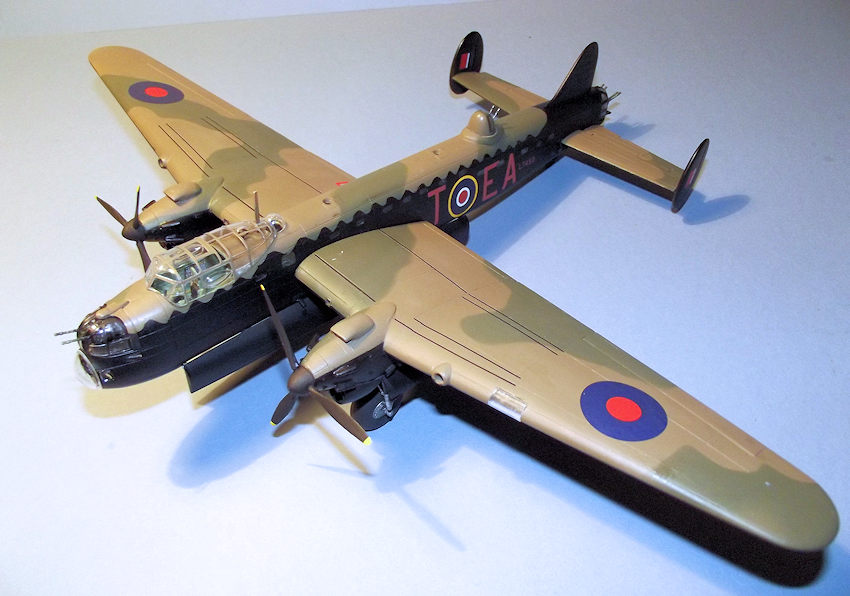
Airfix/Blackbird 1/72 Manchester B.I
| KIT #: | 10694 |
| PRICE: | £68.98 for kit and conversion |
| DECALS: | Via the donor kit, the decal dungeon and a Hannants set for red codes and serials. Budget another £15-00 |
| REVIEWER: | Frank Reynolds |
| NOTES: | Major conversion using elements from different sources. Eduard canopy mask CX 366 price £7-20 |

| HISTORY |
On the 8th March 2016, the London Daily Telegraph published the obituary of Wing Commander Bob Horsley, RAF, DFC, who had passed aged 94. Horsley was awarded his DFC after being shot down during the RAF’s first 1000 bomber raid on the night of May 30/31 1942. He was a recently commissioned radio operator in an Avro Manchester of No 50 Squadron. When the aircraft was fatally damaged over the target, the pilot, Flying Officer Leslie Manser, nursed the crippled aircraft as far as Belgium and heroically stayed at the controls while his crew parachuted to safety. Too low to bail out himself, Manser lost his life as the aircraft crashed. Over the next six weeks the surviving crew were smuggled first by the Belgian, then French, resistance to Spain, then on to Gibraltar and home to England. Based upon the survivor’s reports F/O Leslie Manser was awarded a posthumous Victoria Cross. Bob Horsley retrained as bomber pilot and was later part of a 350 strong Lancaster force that attacked Hitler’s Eagle’s Nest at Berchtesgaden in April 1945.
The Daily Telegraph describes the Manchester as “a bomber whose only claim to fame is that it spawned the Lancaster”.
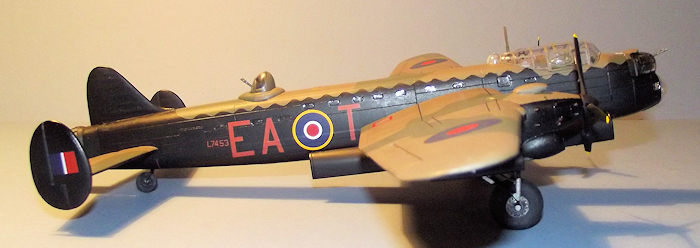 The
Manchester had its origins in a British Air Ministry specification of 1936,
calling for an all-metal twin engine medium bomber. Avro responded with a
proposal and so did Handley Page. The specification mandated the use of a new
engine from Rolls Royce – the Vulture - a minimum bomb capacity of 8,000lb and
power operated gun turrets in the nose and tail. The Avro 679 project promised
to exceed the customer’s specification by providing a 12,000lb bomb load and by
confining fuel storage to the wings, the fuselage could accommodate a massive
bomb bay that stretched two thirds the length of the fuselage. Provision was
also made for dorsal or ventral turrets to increase self -defence. In the style
of British bombers of the period the fuselage sides featured a long row of small
windows so that the type could potentially serve as a bomber-transport, although
it never served in such a role. Handley Page withdrew from the competition
before its twin engine bomber flew. Their design was modified and re-appeared as
a four engine machine – the Halifax.
The
Manchester had its origins in a British Air Ministry specification of 1936,
calling for an all-metal twin engine medium bomber. Avro responded with a
proposal and so did Handley Page. The specification mandated the use of a new
engine from Rolls Royce – the Vulture - a minimum bomb capacity of 8,000lb and
power operated gun turrets in the nose and tail. The Avro 679 project promised
to exceed the customer’s specification by providing a 12,000lb bomb load and by
confining fuel storage to the wings, the fuselage could accommodate a massive
bomb bay that stretched two thirds the length of the fuselage. Provision was
also made for dorsal or ventral turrets to increase self -defence. In the style
of British bombers of the period the fuselage sides featured a long row of small
windows so that the type could potentially serve as a bomber-transport, although
it never served in such a role. Handley Page withdrew from the competition
before its twin engine bomber flew. Their design was modified and re-appeared as
a four engine machine – the Halifax.
The Manchester was certainly cutting edge at the time of its first flight on July 25 1939. Avro had produced a strong airframe with an unusually high level of crew comfort by the standards of the day and the company already held orders for 400 aircraft for the Royal Air Force. These orders were cut back later to leave a production run of 202.
Although it took two years
of development before the Manchester entered front line service, full production
was under way by late 1939. The prototypes revealed shortcomings in the design
that resulted in a third fin being added to the tail plane and the wingspan
increased by ten feet. The 28 feet span tail plane with its distinctive oval
fins was increased to 33 feet span after the first 20 aircraft and in a later
version, the Mk.1a, the central fin was deleted while the fins were enlarged to
the familiar “Lancaster” s tyle.
Operational Manchesters were plagued with hydraulic faults and engine failures,
both mechanical and as the result of fires, problems with vibration of the
airframe and with tail flutter. The old adage of never attempting to combine a
new engine with a new airframe was never more relevant than with the luckless
Manchester, but the fleet had to struggle on until May 1942 when its replacement
– a four engine version known as the Lancaster began to trickle off the
production lines.
tyle.
Operational Manchesters were plagued with hydraulic faults and engine failures,
both mechanical and as the result of fires, problems with vibration of the
airframe and with tail flutter. The old adage of never attempting to combine a
new engine with a new airframe was never more relevant than with the luckless
Manchester, but the fleet had to struggle on until May 1942 when its replacement
– a four engine version known as the Lancaster began to trickle off the
production lines.
The Manchester had a strong airframe and a creditably large bomb bay, features that would enable the Lancaster to carry bombs of a size and weight scarcely dreamt of when the 1936 bomber specification was drafted. Its service belongs to a time when a desperate Britain had to hurry whatever was available into service. Its front line service spanned February 1941 to October 1942. Of the 202 Manchesters, around 80 were lost on operations and a further 50 due to technical failures.
As happens so often, wars
are fought with whatever is available and it was the courage of the aircrews
that gave Britain vital breathing space until more dependable equipment was
available in quantity.
| THE KIT |
This is manufactured by Blackbird Models as a conversion of the Airfix 1:72 scale Lancaster I/III
The conversion comes in a stout, top opening, pizza tray -type cardboard box and all of the components are in cast resin, consisting of 31 parts in a dense pale green/grey resin and three in clear. The airframe parts are beautifully cast, with subtle recessed panel lines and although some of the casting blocks are large they are aligned in such a way that removing them with a saw does not compromise the detail. The box contents are dominated by the two large outer wing panels that reach from the dihedral break to the wing tip. The wing flaps are cast separately so they can be modelled lowered. The engine nacelles and cowls are combined as one piece units and the three blade propeller units cast in one piece complete with spinner.
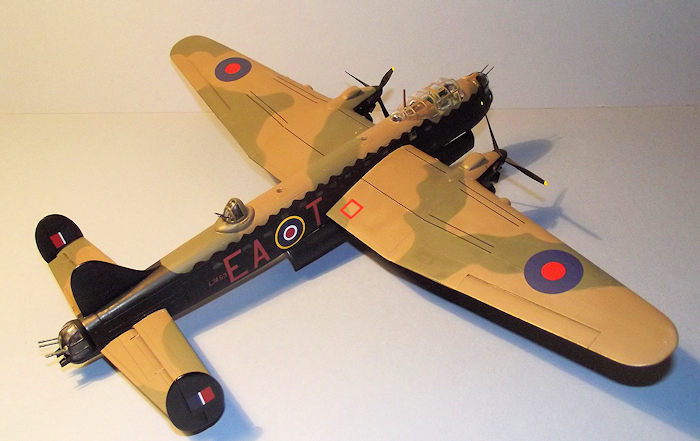 Three clear
cast resin components provide, top turret, tail turret and wing landing light.
This is a bonus for me, since I am not a fan of vacu form transparencies. They
were found to be rather cloudy, with prominent frame lines but little could be
done to alter this.
Three clear
cast resin components provide, top turret, tail turret and wing landing light.
This is a bonus for me, since I am not a fan of vacu form transparencies. They
were found to be rather cloudy, with prominent frame lines but little could be
done to alter this.
Plenty of time needs to be spent in researching the version to be modelled, since Manchesters show significant variations in the airframe specification, so good references are needed.
Between the prototypes, Mark 1s and Mark 1As there are: Three different tail layouts; Two types of engine exhausts; Mid upper, ventral or no midships turret. In terms of paint finishes there are three different types of fuselage roundel, two different types of tail fin flash and three versions of the demarcation line between upper and lower colours on the fuselage.
No decals or marking information is provided in the Blackbird Models package and since I wanted to build an example that had the maximum possible differences from a Lancaster, it took a while to work out the best balance of features that I needed, balanced against the availability of suitable decals.
For years it has been the
accepted wisdom that the Avro Manchester has two distinct tail plane
configurations; the early Mk.1 having a 28ft span triple tail arrangement and
the later Mk.1A a 33ft wide twin fin layout that would become familiar on the
Lancaster. The latest research now indicates that only a few of the earliest
Manchesters had the 28ft span tail and that on most of the Mk.1s, even though
they had a triple fin tail, it was a 33ft wide unit. Now Blackbird provide resin
parts for the short span triple tail, but is easy enough to combine the three
resin fins with the standard Lancaster horizontal tail from a donor kit.
Blackbird only provides the early short engine exhaust shrouds, so this limits
the choices of finish availabl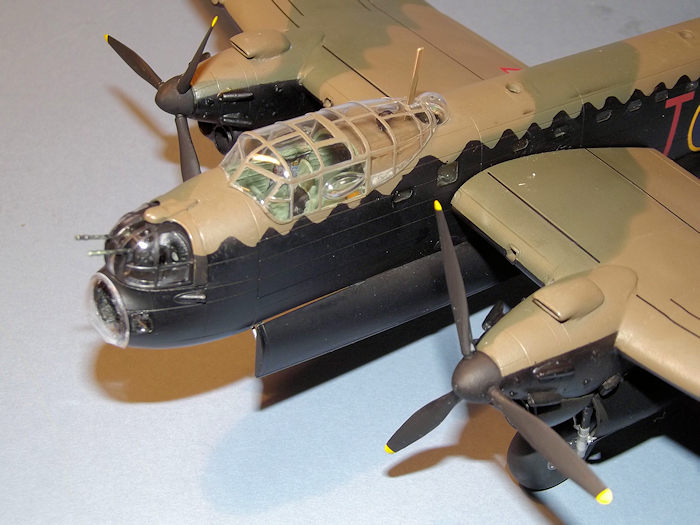 e
and I was also driven by the need to find aftermarket decals with appropriate
codes and serials that blended with Airfix’s standard Lancaster sheet to get an
acceptable combination of national markings, squadron codes and serial numbers.
e
and I was also driven by the need to find aftermarket decals with appropriate
codes and serials that blended with Airfix’s standard Lancaster sheet to get an
acceptable combination of national markings, squadron codes and serial numbers.
This proved to be a major research exercise and although an ancient Profiles booklet from the Reynolds’ dusty archives was a useful primer, the essential reference was the invaluable Warpaint Publications soft cover book, causing the wallet to take another bashing to the tune of £12-00.
A little further work was needed when I discovered that a Manchester’s propellers are larger than that of a Lancaster, stated to be 16ft diameter, nearly 66mm in 1:72 scale. It is evident that the supplied resin items have Lancaster-like blades that are about 3mm too short. A hunt through my spares box yielded two props that started life with Airfix 1:48 scale Mk.1 Spitfires and they looked to be good enough for my purposes. The web debate has also established that a Manchester’s main wheels are of smaller diameter than that of a Lancaster but I drew the line at this detail and mine wears Lanc boots.
| CONSTRUCTION |
I prefer to cut, trim and sand all of the resin parts at an early stage so that they can be built into the airframe with a minimum of fuss. So armed with a brand new razor saw blade, a new dust filter mask and some wet and dry abrasive paper I set to work. The potential dangers of resin dust are well known so a good mask and good ventilation are essential. The clean castings and good definition of the cut lines made the work straight forward but a bit of a slog and I estimate that a total of some three hours cutting and sanding was needed spread over two modelling sessions. The resin parts were then washed in a mild detergent solution and left to dry overnight.
Now it was time to hack
the Airfix parts about before any assembly took place. Blackbird’s careful
design means that most of the required saw cuts occur along panel lines in the
Airfix mouldings so a straight-backed razor saw was used to remove the outer
wings at the dihedral break. It certainly helps if you have already made one or
two of the Airfix Lancs to get a feel for basic assembly, but not essential. I
went through the parts frames and removed all of the components that would not
be required for the
 Manchester,
such as the engines, propellers, mid upper and tail turrets, rudders, and outer
wing flaps.
Manchester,
such as the engines, propellers, mid upper and tail turrets, rudders, and outer
wing flaps.
Construction began with the standard Airfix Lancaster fuselage assembly. This is my fifth build of the same basic structure, three of which have already appeared on MM, so I will pass on a blow by blow account. The core of the fuselage is the bomb bay roof/floor with its internal bulkheads and cockpit assembly and this was assembled first and left to set hard. There are two massive wing spars with integral bulkheads fixed across the long floor structure and these are threaded though vertical slots in the fuselage sides when the fuselage halves are closed up. The Manchester fuselage interior layout is very similar to that of the standard Lancaster so the Airfix parts were used with little alteration other than eliminating the radar set. The interior was sprayed in Tamiya XF-71 Cockpit Green with the nose area and instrument panels finished in XF-1 Flat Black. It seems that the Manchester was specified to have a co-pilot who could use the fold down seat provided by Airfix, so a second control wheel has to be sourced for the starboard side of the cockpit
The bomb bay/wing spar unit was glued into the left side fuselage and the assembly left to harden overnight . The fuselage right side was threaded into place and glued with Revell Contacta to provide a strong joint. As before with these Airfix parts, I found the long thin fuselage halves to be slightly warped and the whole fuselage structure had to be tightly strapped with masking tape until the glue dried. In spite of my best efforts a smear of filler was needed along the joint lines between the two halves.
The projecting wing spars were trimmed back to project about 15mm from the fuselage sides, with the offcut sections set aside for incorporation in the wing centre sections.
The Airfix wings were
drastically reduced by sawing off the outer panels at the dihedral break. The
inner sections of the Airfix wings have a complex interior framework that needs
to be glued into place to form a box structure around the wheel wells. This
consists of sections of the front and rear spars, full depth ribs to the sides
and half ribs that detail the roof of the wheel wells. Airfix intends that there
should be a small rear bulkhead to this area and two projecting rib webs that
slide inside the nacelle, but after a trial fit of the resin replacement
nacelles I cut back the rib projections and omitted the small bulkheads so as to
get the new  nacelles
to sit down over the wing. The upper and lower parts of the Airfix inner wings
were glued together and left for a couple of days to set really hard before the
outer wing panels were attached. I now had a couple of styrene inner wing
sections that could be slid on and off the fuselage’s projecting wing spars.
nacelles
to sit down over the wing. The upper and lower parts of the Airfix inner wings
were glued together and left for a couple of days to set really hard before the
outer wing panels were attached. I now had a couple of styrene inner wing
sections that could be slid on and off the fuselage’s projecting wing spars.
The replacement outer wing panels are massive one piece castings, incorporating the ailerons, although resin wing flaps are separate parts. Moulded to the correct dihedral angle, they are intended to butt join against the Airfix inner wing and I formed the initial joint with quick drying super glue. I then mixed some five-minute epoxy resin and, using a cocktail stick, poked blobs of the wet resin through the holes in the wheel bay ribs so that it spread across the internal part of the resin to plastic joint. Satisfied that the joint was strong enough and the wing was correctly aligned I left these major components alone for a week to cure fully before tidying up the joint with some Green Stuff filler.
The horizontal tail sections were assembled from the Airfix parts and a slot cut on the spine of the rear fuselage to accept the third tail fin. The vertical tail fins were tacked in place with super glue, the well-engineered resin parts fitted without fuss.
A check of available references revealed a number of holes that needed to filled in the Airfix fuselage, those provided for variants of Lancaster that were not relevant to this project, such as the towel rail antenna and light apertures under the rear fuselage, pitot tube under the nose and two small aerials forward of the windscreen. The scribed areas for two windows on the spine and under the nose were opened up with a small drill. The resin fairing for the mid upper turret simply clicked into place without fuss and was secured with a drop of superglue. I now had a wingless fuselage and tail assembly that was cleaned up and the main cabin glazing was stuck in place and masked using the Eduard masking set.
The two resin propeller assemblies were modified by cutting off the blades and replacing them with larger plastic ones harvested from a 1:48 Spitfire. The new blades were seated into holes drilled into the resin spinners and secured with super glue. They were painted and set aside for installation later.
Next I began the sub-assemblies for the engines. Blackbird Models go for large one piece structures, which is no bad thing and the engine cowlings are formed as one unit with the rear part of the nacelles and the wing leading edge fairing, even including the smallest air scoops, all in the one casting. To this are added the twin scoop chin radiators which have a separate cooling flap, the main upper air intake and four small exhaust fairings to the cowling sides. All of the parts had positive locations and assembled fairly easily with super glue, needing only a light smear of filler to some of the joints. I was pleased to find that the completed units were well engineered to fit the Airfix wing parts and almost clicked into place when test fitted. However it would be a way to go before they were finally glued since the main gear assembly needed some more drastic work.
Due to the thickness of
the resin parts, the Airfix gear legs will not fit inside the new nacelles
without some fairly drastic rework. The Airfix parts are designed so that the
upper legs splay out inside the nacelles but they need to be parallel for the
Manchester kit. Mindful of the fact that the gear legs had to support the
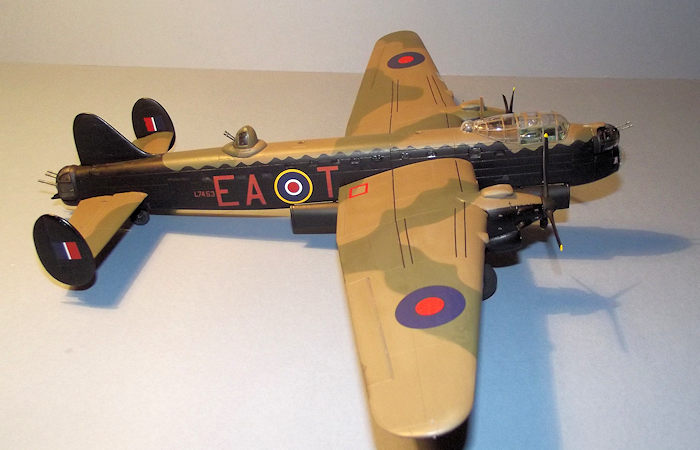 not
inconsiderable weight of the resin wings I cut out the cross struts from the
gear assembly, bent the legs straight, then built up some strengthening plates
from plastic card. Not scale, but strong (please do not look inside the main
gear bays of my model). After a bit more dry fitting and fettling I was
satisfied that the main gear legs could be located onto the front face of the
wing spars when the engine nacelles were installed.
not
inconsiderable weight of the resin wings I cut out the cross struts from the
gear assembly, bent the legs straight, then built up some strengthening plates
from plastic card. Not scale, but strong (please do not look inside the main
gear bays of my model). After a bit more dry fitting and fettling I was
satisfied that the main gear legs could be located onto the front face of the
wing spars when the engine nacelles were installed.
The nacelles were fixed to the wing structures with superglue and small gaps filled with Green Stuff putty.
The wing structures were sprayed over all in grey auto primer from a rattle can and this was then gently removed with fine grade sanding sticks to check that all of the parts were aligned, then the main airframe parts were re-sprayed in primer ready for the final coats of paint.
Attention now turned to the turrets. The nose turret assembly is the easiest since it is the standard Airfix item. The mid upper and tail turrets were more of a challenge since the resin transparencies were thick, chunky, and rather cloudy . Each has a resin base and they fitted the spaces they were intended to occupy reasonably well, although the thickness of the transparencies meant that it was not possible to fit the turret interiors from the Airfix parts so I just cobbled together a support frame for the guns from scrap plastic and painted the turret interiors Black. Each of the two resin turrets were masked with carefully applied Tamiya tape, the nose turret having the luxury of those beautifully designed Eduard masks.
| COLORS & MARKINGS |
The upper surfaces were painted in Xtracrylix XA 1002 Dark Earth applied by my Iwata HP-C airbrush. The relevant areas were masked off with Tamiya tape and the contrasting camouflage of Tamiya XF-81 Dark Green was applied. When the paint had dried enough the upper surfaces were masked off with what seemed like masses of Tamiya tape ready for the application of Tamiya X-18 semi-gloss Black to the sides and under surfaces. The very distinctive wavy line to the fuselage colour demarcation was achieved by laying appropriate lengths of Tamiya 10mm tape onto a sheet of glass, then drawing the shape with a soft pencil so that a stencil could be cut using a fresh scalpel blade.
On completion of the paintwork the masking was stripped away with the exception of the masking to the cockpit area and the whole airframe treated to two hand brushed coats of Future/Klear floor polish prior to the application of decals.
The subject chosen was L7453 of No 49 Sqn, Royal Air Force, Scampton, mid- 1942.
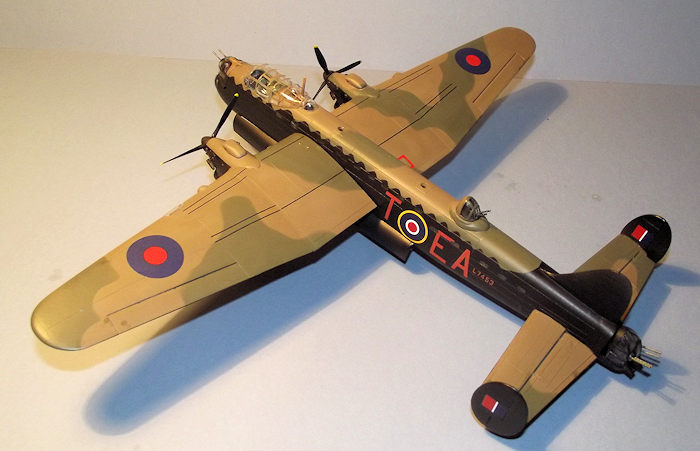 The
fuselage roundels came from the Airfix donor kit and the tail flashes, trimmed
down, from the same source. Xtradecal provided the Dark Red squadron codes and
serials in their set X72RAF2, which includes four of their sheets that are
normally available separately, for a total price of £11-99 for the 4-pack, which
I consider to be a reasonable bargain. (The fact that the squadron code letters
on the left hand side of the fuselage spell out a favourite British beverage is
co-incidental.)
The
fuselage roundels came from the Airfix donor kit and the tail flashes, trimmed
down, from the same source. Xtradecal provided the Dark Red squadron codes and
serials in their set X72RAF2, which includes four of their sheets that are
normally available separately, for a total price of £11-99 for the 4-pack, which
I consider to be a reasonable bargain. (The fact that the squadron code letters
on the left hand side of the fuselage spell out a favourite British beverage is
co-incidental.)
The upper wing was finished with wing walks modified from the Airfix set and the roundels, which are smaller than those found on a Lancaster due to the wing taper, came from a sheet for a 1:48 Spitfire. Minor airframe stencilling and trestle locations came courtesy of the Airfix Lancaster.
The decals were sealed with a further hand brushed coat of Future/Klear then finished with two lightly misted airbrushed coats of Xtracrylix Flat Varnish. The 28 small windows to the fuselage were glazed with Micro Kristal Klear applied with the tip of a toothpick. This method is invaluable when small windows are required since it saves the masses of tedious masking that would be needed if the windows were glazed with plastic components early in the build.
Installation of the bomb bay doors was made more difficult than it need be due to warped plastic parts, a problem that is not unusual in Airfix kits of the last couple of years. The edges of the bomb bay and the matching large doors are commendably thin but provide a very narrow joining area and slight warping of the joining faces provided even less area to join face to face. I managed to bend to doors back to an approximation of straight and tacked them in place with tube cement while they set, alignment being aided by the V-shaped front and rear struts that fix between the bomb bay bulkheads and the doors. The interior of the bomb bay was just furnished with empty bomb shackles.
Installing the main gear units proved to be tricky since engine/nacelle resin castings lack precise location points for the legs and struts and they had to be juggled into position then fixed with quick setting epoxy. The gear doors were easier to fix since the Airfix plastic versions have a built in steadying strut that assists alignment.
Construction was completed with the installation of the gun turrets , the bomb aimer’s nose blister and a radio aerial to the rear of the cockpit that was fashioned from an offcut of plastic card.
| CONCLUSIONS |
Initially this looked to be a straight forward build, mainly straight saw cuts and swapping out some Airfix parts for the resin ones. The real work came in filling and blending plastic and resin together. The work required to the main gear assembly was a surprise, but not an insurmountable problem. It was a satisfying construction exercise and stands at about mid-point in complexity for a conversion.
A lot of extra time and effort is needed to research colour schemes and source suitable decals.
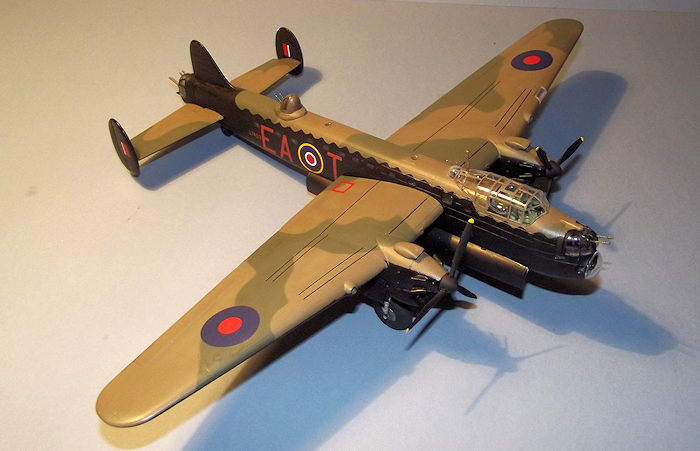 I feel that
Blackbird has come up short with its package in not offering decals and little
being provided in the way of camouflage and markings information . After market
decals are hardly plentiful for the Manchester and this seems to be a
significant omission, given that other after-market companies, such as Fisher
Model in the USA and Alley Cat in the UK, provide well researched and
comprehensive equipped conversion packages of similar style.
I feel that
Blackbird has come up short with its package in not offering decals and little
being provided in the way of camouflage and markings information . After market
decals are hardly plentiful for the Manchester and this seems to be a
significant omission, given that other after-market companies, such as Fisher
Model in the USA and Alley Cat in the UK, provide well researched and
comprehensive equipped conversion packages of similar style.
The requirement to replace the prop blades and , for the more fastidious, to find replacement main wheels, is an unwanted irritation.
I am inclined to give Blackbird 7 out of 10 for this conversion; the resin parts are excellent and as good as any that I have seen, but the sketchy supporting information and lack of decals weighs against it. This exercise was not cheap, by the time I had finished I had spent around £100.
So, well done Blackbird Models for enabling me to fill a gap in my collection of Avro heavies, but it could have been even better.
| REFERENCES |
Avro Manchester by Chaz Bowyer. Aircraft Profile No 260. Profile Publications Ltd 1974
Avro Manchester by Tony Buttler. Warpaint series No. 103.
This package courtesy of my wallet.
21 October 2016
Copyright ModelingMadness.com
If you would like your product reviewed fairly and fairly quickly, please contact the editor or see other details in the Note to Contributors.